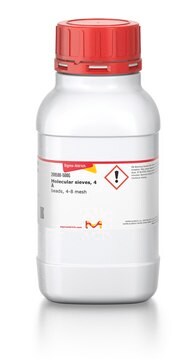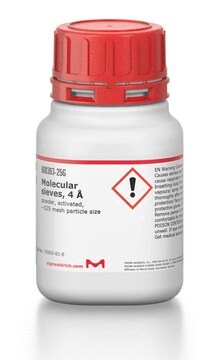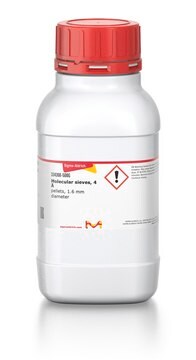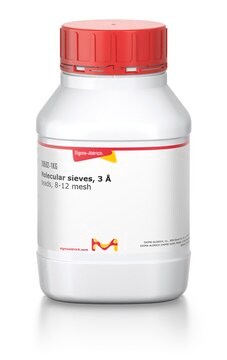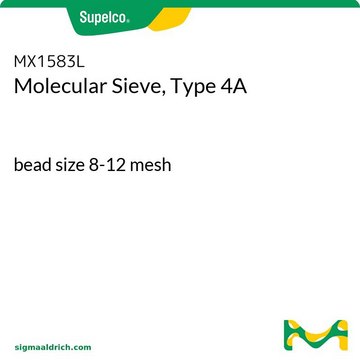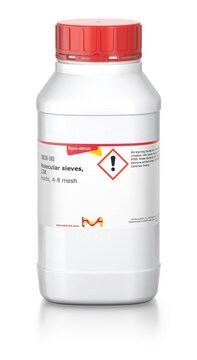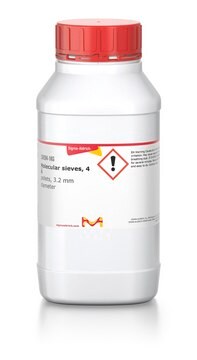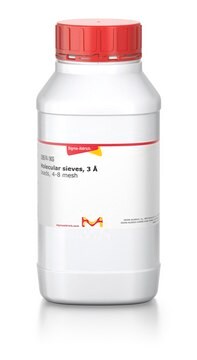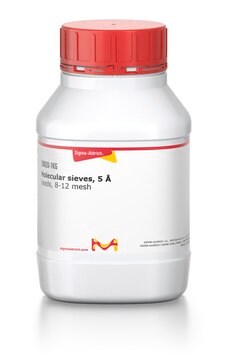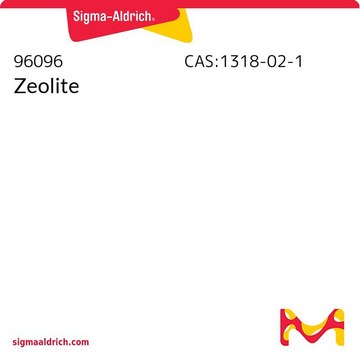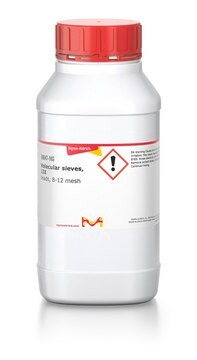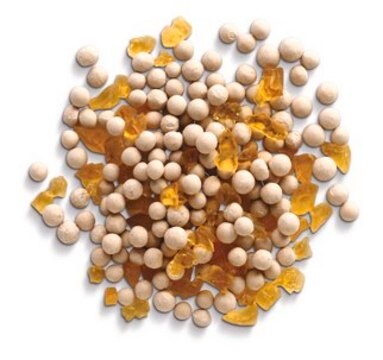208604
Molecular sieves, 4 Å
beads, 1.6-2.5 mm
Se connecterpour consulter vos tarifs contractuels et ceux de votre entreprise/organisme
About This Item
Formule linéaire :
Na12[(AlO2)12(SiO2)12] · xH2O
Numéro CAS:
Numéro MDL:
Code UNSPSC :
23201100
eCl@ss :
32110204
Nomenclature NACRES :
NB.24
Produits recommandés
Forme
beads
Taille des particules
1.6-2.5 mm
Dimension de pores
4 Å
Vous recherchez des produits similaires ? Visite Guide de comparaison des produits
Catégories apparentées
Description générale
Choosing a Molecular Sieve:
1. The preferential adsorption of one molecule over another depends upon pore diameter and mesh size.
2. The dynamic capacity of the silica gel for adsorbing a particular compound is governed by the internal surface area; the greater the surface area, the greater the dynamic capacity.
3. Rate of adsorption and sharpness of resolution are dependent chiefly on particle size and column packing; a fine particle size gives optimum sharpness of resolution.
4. Liquids are most readily adsorbed from solvents in which they are least soluble; a good solvent makes a good desorbing agent.
5. Highly polar liquids are readily adsorbed. Compounds having hydroxyl groups, or containing oxygen are strongly adsorbed.
6. For similar compounds, the higher the molecular weight the higher the selectivity.
7. For hydrocarbons of similar molecular weight, adsorptivity increases with the number of double bonds.
1. The preferential adsorption of one molecule over another depends upon pore diameter and mesh size.
2. The dynamic capacity of the silica gel for adsorbing a particular compound is governed by the internal surface area; the greater the surface area, the greater the dynamic capacity.
3. Rate of adsorption and sharpness of resolution are dependent chiefly on particle size and column packing; a fine particle size gives optimum sharpness of resolution.
4. Liquids are most readily adsorbed from solvents in which they are least soluble; a good solvent makes a good desorbing agent.
5. Highly polar liquids are readily adsorbed. Compounds having hydroxyl groups, or containing oxygen are strongly adsorbed.
6. For similar compounds, the higher the molecular weight the higher the selectivity.
7. For hydrocarbons of similar molecular weight, adsorptivity increases with the number of double bonds.
Molecular sieves are crystalline metal aluminosilicates having a three-dimensional interconnecting network of silica and alumina tetrahedra. Natural water of hydration is removed from this network by heating to produce uniform cavities which selectively adsorb molecules of a specific size. This 4A form with sodium ions has the effective pore opening of 4Å, thus excluding molecules of effective diameter >4Å (for example: propane). The 8 to 12-mesh type is common in liquid-phase applications. Molecular sieves are considered a universal drying agent in polar and nonpolar media.
Regeneration or Activation:
A saturated molecular sieve can be restored to its original capacity by regeneration, the principle of which involves changing the conditions surrounding the adsorbent to correspond to a very low equilibrium capacity. In general, the greater the difference between the equilibrium capacities of adsorption and regeneration, the more rapid and complete the regeneration.
The sieve may be regenerated in one of four ways:
1. Thermal reactivation –The maximum regeneration temperature for Silica is 300°C.
2. Pressure reactivation
3. Passing an appropriate fluid through the gel bed at normal temperature and pressure.
4. Displacement of adsorbates by passing a high concentration of molecules in a fluid through the bed.
A saturated molecular sieve can be restored to its original capacity by regeneration, the principle of which involves changing the conditions surrounding the adsorbent to correspond to a very low equilibrium capacity. In general, the greater the difference between the equilibrium capacities of adsorption and regeneration, the more rapid and complete the regeneration.
The sieve may be regenerated in one of four ways:
1. Thermal reactivation –The maximum regeneration temperature for Silica is 300°C.
2. Pressure reactivation
3. Passing an appropriate fluid through the gel bed at normal temperature and pressure.
4. Displacement of adsorbates by passing a high concentration of molecules in a fluid through the bed.
Application
Molecular sieves, 4 Å may be used in the following processes:
- Static dehydration in closed liquid or gas systems such as in packaging of drugs, electric components and perishable chemicals.
- Water scavenging in printing and plastics systems.
- Drying saturated hydrocarbon streams by adsorbing gases such as sulfur dioxide, carbon dioxide, hydrogen sulfide, ethene, ethane and propene.
The product (Molecular sieves, 4 Å) has been used for the removal of all traces of water from various solvents (methanol, methanol-acetone and acetone). Also, they have been used for drying during the preparation of solutions of N-hydroxysuccinimide (NHS) and biotin-NHS esters (1gL-1) in dried ACN (acetonitrile).
Code de la classe de stockage
11 - Combustible Solids
Classe de danger pour l'eau (WGK)
WGK 3
Point d'éclair (°F)
Not applicable
Point d'éclair (°C)
Not applicable
Faites votre choix parmi les versions les plus récentes :
Déjà en possession de ce produit ?
Retrouvez la documentation relative aux produits que vous avez récemment achetés dans la Bibliothèque de documents.
Les clients ont également consulté
Evgeny Pavlov et al.
Biophysical journal, 88(4), 2614-2625 (2005-02-08)
We examined ion channels derived from a chloroform extract of isolated, dehydrated rat liver mitochondria. The extraction method was previously used to isolate a channel-forming complex containing poly-3-hydroxybutyrate and calcium polyphosphate from Escherichia coli. This complex is also present in
Quantification of N-hydroxysuccinimide and N-hydroxysulfosuccinimide by hydrophilic interaction chromatography (HILIC).
Klykov O and Weller MG.
Analytical Methods : Advancing Methods and Applications, 7(15), 6443-6448 (2015)
Notre équipe de scientifiques dispose d'une expérience dans tous les secteurs de la recherche, notamment en sciences de la vie, science des matériaux, synthèse chimique, chromatographie, analyse et dans de nombreux autres domaines..
Contacter notre Service technique